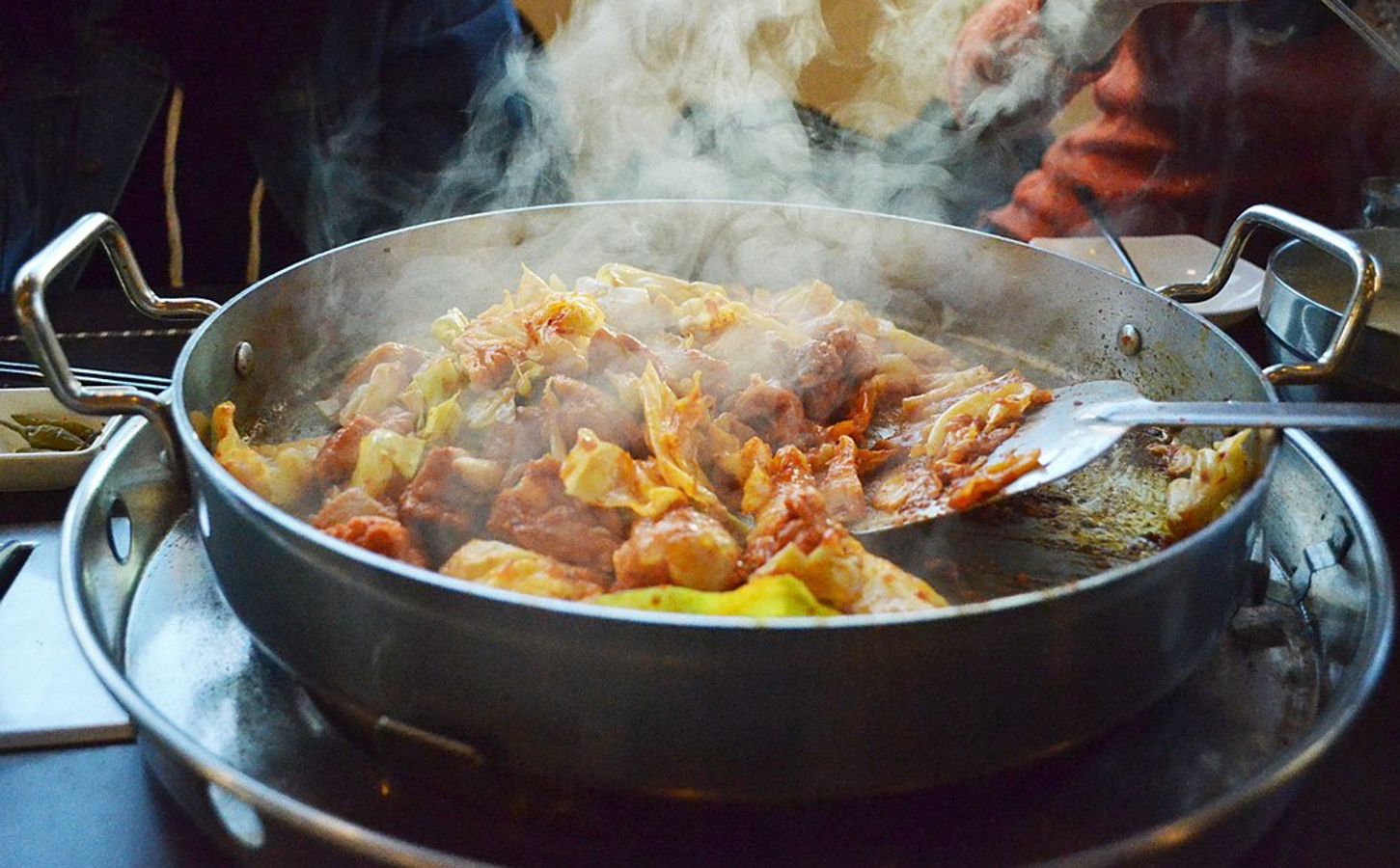If you love spicy, bold flavors, Seoul is the food-city for you!
Take a break from exploring UNESCO heritage sites and shopping to explore some of Seoul’s mouth-watering food choices. With a population of more than ten million, this super-city is a treasure trove of literally thousands of fantastic restaurants. Seoul has it all: restaurants specializing in every type of food, countless streetside vendors and large specialty food markets.
Today, we want to introduce you to 11 dishes to try while you’re in Seoul — from mouthwatering barbecue to crispy chicken fried to perfection, your taste buds will be wanting for more.
So let us check out our guide below to 11 Delicious Dishes to Try in Seoul:
Tteokbokki are long cylindrical rice cakes slathered in a bright red, sweet and spicy sauce. The rice cakes have a pleasant chewy but firm texture — soft with a certain elasticity, cooked with fish cake, vegetables, and boiled eggs. Some variations add ramen and even cheese to the top! Tteokbokki is a favorite comfort food for many Koreans and is served everywhere from tiny street-side stalls to popular restaurants. This iconic dish is must-try for tourists.
2. Sannakji (Live Baby Octopus)

The dish consists of a live baby octopus that is chopped up, drizzled with sesame oil and sprouts, then served raw. The octopus tentacles, with nerves still pulsing, squirm in the serving dish, playfully taunting the diner.
Be sure to chew thoroughly before swallowing, in order to avoid any hazards that the moving tentacles might pose on its way down. The entire experience may seem a bit challenging to stomach (no pun intended), but the freshness of the octopus paired with sesame oil is quite delicious.
3. Dakgangjeong (Korean Fried Chicken)

Korean fried chicken packs flavor, crunch, and juiciness into every bite. Unlike other fried chickens, korean fried chicken is double fried, which reduces the oiliness of batter, locks in the moisture of the meat, and creates a pleasurable crispy exterior. Then, the chicken pieces are either glazed in a variety of sweet or spicy sauces, tossed together with garlic and chives, or served plain.
The best way to enjoy fried chicken is with a glass of Korean beer. The term chimaek (chicken-beer) was specially formulated to describe this combo. Plus, many shops will deliver right to your door if you want to enjoy chimaek at home!
Fun fact: Perhaps as an ironic dotage to the famous American fast food chain, locals also affectionately refer to their version of fried chicken as ‘KFC’. Obviously, the K doesn’t stand for Kentucky in this case.
4. Gogigui (Korean BBQ)

Grills are built right into the tabletop and diners are tasked with cooking the meat themselves. Patrons gather around the communal grill to drink and chat while perfecting the char on delicious cuts of crispy pork belly (samgyeopsal), juicy marinated beef (bulgogi), flavorful beef short rib (kalbi), and more.
Like all Korean meals, Korean barbecue also includes an extensive selection of side dishes like kimchi, pickled daikon, and marinated fish cakes to add some acidity to the protein-fest. Wrap the grilled meat in some lettuce with rice and fermented spicy bean ssam sauce, and you’ve got the perfect bite!
Pro-tip: It is inevitable to leave the restaurant without your clothes and hair smelling like barbecue, so plan your schedule and wardrobe accordingly.
5. Jajangmyun (Black Bean Noodles)

Though the list of dishes is extensive, one of the most popular of is jajangmyun, taken from the northern Chinese dish, zhajiangmian– which translates to mean ‘fried sauce noodles’. Jajangmyun is a noodle dish with sweet and savory thick fermented black bean sauce, minced pork, onion, and cucumbers draped over thick chewy noodles. While it resembles its dark-sauced Chinese sibling, the Korean version is noticeably darker in color and slightly sweeter in taste. While both versions are delicious, you’ll definitely want to try these yummy noodles while you’re in town.
Fun fact: According to South Korean tradition, those who find themselves single on Valentines Day grieve their shared singleness by wearing black and eating jajangmyun.
6. Patbingsu (Shaved Ice)

Patbingsu is the Korean take on shaved ice– pillowy mounds of shaved ice topped with everything from chopped fruit to red bean paste, or condensed milk. This cold treat is the perfect way to cool off in the heat, or to follow-up a hearty meal.
You can find Patbingsu in cafes, restaurants, or in shops specializing only in patbingsu. Whether you prefer smooth, silky milk based ice topped with chopped fruits or the balanced matcha green tea-based ice, there are patbingsu flavors to satisfy every sweet tooth.
Budae Jjigae directly translates to mean Budae (Military base) Jigae (Soup/Stew). The term originates from budae jjigae’s origins as a wartime food. Because of the struggling economy at that time, the soup features low-cost Western staples like spam, sausage, American cheese, and baked beans, reflecting the rations provided to the army and the region’s American presence.
Despite its humble origins, the stew has remained a favorite for locals even decades after the war and is eaten regularly throughout the country. Nowadays, budae jjigae contains spam, ramen noodles, rice cake, vegetables, sliced cheese, and even the occasional baked bean. While these ingredients might seem dissonant and random, they come together in the pot with a mysterious ease. The result is a spicy, salty yet comforting broth that would satisfy the cravings of any hungry soldier.
8. Hotteok

Hotteok is a small circular Korean pancake usually sold on the streets of Seoul. The pancake is served piping hot, with a crispy exterior and a gooey soft interior and is filled with a warm caramelized cinnamon sugar syrup, though sometimes it also houses savory fillings like vegetables and glass noodles. Some variations of hotteok are chewier (made glutinous rice flour) while others are crispier and almost fritter-like (made with cornstarch).
If you are looking for a small snack to warm your belly, hotteok will certainly not disappoint.
9. Samgyetang (Ginseng Chicken Soup)

Among these, one of our favorites is samgyetang, or ginseng chicken soup. Samgyetang is an extremely healthy soup, known replenish and nourish the body. It is made from a whole young chicken boiled in Korean ginseng, jujube fruit, garlic glutinous rice, and a variety of medicinal herbs.
Ironically, samgyetang is a common food during summer months, as many Koreans believe you need to balance the temperature of summer by heating up your body as well. So don’t think it strange when on the hottest days of summer, you find locals slurping spoonfuls of the hot soup while sweat drips down their brow.
Dakgalbi is a spicy, marinated chicken stir-fried with gochujang (chili paste), cabbage, sweet potato, onions, rice cake, and perilla leaves. It is the perfect dish to order and share with a table of friends. Servers bring a skillet to the table and prepare the dish before the guests.
The best part is that when guests are almost finished eating, you can request for the server to make fried rice with the dakgalbi. Rice is added to what’s left of the dish, stir-fried again and re-served as fried rice!
Kimbap, a Korean sushi roll, is widely available all around Seoul from markets to street vendors. It is a lunchtime favorite, often packed into school lunches by loving Korean mothers.
Unlike Japanese sushi, however, kimbap is seasoned with sesame oil rather than rice vinegar. While the assortment of fillings ranges far and wide, Kimbap is usually stuffed with vegetables like carrots, pickled radish or spinach and a protein like beef, imitation crab or eggs.
Portable and healthy, kimbap is the perfect grab and go meal when you’re looking to sit down in a beautiful park and have a picnic.
This is it!
These were the top 11 Delicious Dishes to Try in Seoul. Hopefully, you’ve gotten some insight on what you must eat in Seoul and had a delicious time doing so!
If you’re interested in a cooking class, there are many great options on www.cookly.me.











